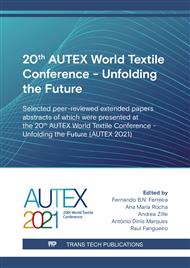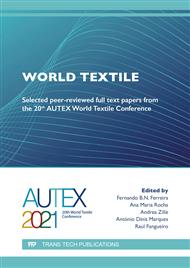[1]
V. Ramaswamy, F. Gouillart, Building the Co-Creative Enterprise, Harv. Bus. Rev.(2010) 1–9.
Google Scholar
[2]
Y. Wang, H.-S. Ma, J.-H. Yang, K.-S. Wang, Industry 4.0: a way from mass customization to mass personalization production, Adv. Manuf., 5 (2017) 311–320.
DOI: 10.1007/s40436-017-0204-7
Google Scholar
[3]
M. Christopher, R. Lowson, H. Peck, Creating agile supply chains in the fashion industry, Int. J. Retail Distrib. Manag., 32, 8 (2004) 367–376.
DOI: 10.1108/09590550410546188
Google Scholar
[4]
M. Bruce, L. Daly, N. Towers, Lean or agile: A solution for supply chain management in the textiles and clothing industry?, Int. J. Oper. Prod. Manag., 24, 2, (2004) 151–170.
DOI: 10.1108/01443570410514867
Google Scholar
[5]
W. Stengg, The textile and clothing industry in the EU, 2, (2001).
Google Scholar
[6]
R. M. Jones, Statistical Review The UK clothing industry and market - An update, J. Fash. Mark. Manag., 4, 2, (2000) 182–187.
Google Scholar
[7]
D. Prajogo, J. Olhager, Supply chain integration and performance: The effects of long-term relationships, information technology and sharing, and logistics integration, Int. J. Prod. Econ., 135, 1, (2012) 514–522.
DOI: 10.1016/j.ijpe.2011.09.001
Google Scholar
[8]
M. Christopher, D. R. Towill, Supply chain migration from lean and functional to agile and customised, Supply Chain Manag. An Int. J., 5, 4, (2000) 206–213.
DOI: 10.1108/13598540010347334
Google Scholar
[9]
M. Jin, H. Wang, Q. Zhang, Y. Zeng, Supply chain optimization based on chain management and mass customization, Inf. Syst. E-bus. Manag., 18, 4, (2020) 647–664.
DOI: 10.1007/s10257-018-0389-8
Google Scholar
[10]
J. Ben Naylor, M. Naim, D. Berry, Leagility: integrating the lean and agile manufacturing in the total supply chain, Int. J. Prod. Econ., 62, (1999) 107–118.
DOI: 10.1016/s0925-5273(98)00223-0
Google Scholar
[11]
R. Jones, The Apparel Industry, second ed., Blackwell Publishers, Aylesbury, (2006).
Google Scholar
[12]
A. Popp, Swamped in information but starved of data': Information and intermediaries in clothing supply chains, Supply Chain Manag. An Int. J., 5, 3, (2000) 151–161.
DOI: 10.1108/13598540010338910
Google Scholar
[13]
S. Gupta and S. K. Jain, A literature review of lean manufacturing, Int. J. Manag. Sci. Eng. Manag., 8, 4, (2013) 241–249.
Google Scholar
[14]
R. H. Lowson, Retail Sourcing Strategies: Are They Cost-effective?, Int. J. Logist. Res. Appl., 4, 3, (2001) 271–296.
Google Scholar
[15]
K. A. Goforth, Adapting lean manufacturing principles to the textile industry, Carolina State University, (2007).
Google Scholar
[16]
J. Bhamu, K. S. Sangwan, Lean manufacturing: Literature review and research issues, Int. J. Oper. Prod. Manag., 34, 7, (2014) 876–940.
DOI: 10.1108/ijopm-08-2012-0315
Google Scholar
[17]
T. James, Wholeness as well as Leanness, IET, Manufacturing Engineer, (2006) 14–17.
Google Scholar
[18]
S. Chong, Business process management for SMEs: an exploratory study of implementation factors for the Australian wine industry, J. Inf. Syst. Small Bus., 1, 1, (2007) 41–58.
Google Scholar
[19]
P. Achanga, E. Shehab, R. Roy, G. Nelder, Critical success factors for lean implementation within SMEs, J. Manuf. Technol. Manag., 17, 4, (2006) 460–471.
DOI: 10.1108/17410380610662889
Google Scholar
[20]
R. P. Mohanty, O. P. Yadav, R. Jain, Implementation of Lean Manufacturing Principles in Auto Industry, Ind. Eng. Lett., 1, 1, (2007) 1–32.
Google Scholar
[21]
A. Berg, Less is the new more: The state of fashion in 2021, McKinsey & Company, (2021)1-3.
Google Scholar
[22]
A. B. Costa, Reforçar a competitividade da ITV portuguesa, Simpósio da ITV Regenerar o Setor, Ganhar o Futuro – Uma Visão Estratégica para a Década.,, (2021).
Google Scholar
[23]
N. Arora, W. Liu, K. Robinson, E. Stein, D. Ensslen, L. Fiedler, G. Schler, The value of getting personalization right or wrong is multiplying, McKinsey & Company, (2021) 1-12.
Google Scholar
[24]
Y. Tu, B. Neuhofer, G. Viglia, When co-creation pays: stimulating engagement to increase revenues. International Journal of Contemporary Hospitality Management, (2017) 1-32.
DOI: 10.1108/ijchm-09-2016-0494
Google Scholar
[25]
D. Fedewa, C. Holder, W. Teichner, B. Wiseman, Five-star growth: Using online ratings to design better products, McKinsey & Company, (2021) 1-13.
Google Scholar
[26]
C. F. von Maltzahn, Co-Creating Individuals : A Roadmap to Value Creation in Fashion Retailing, (2016).
Google Scholar
[27]
F. T. Piller, Open Innovation with Customers: Crowdsourcing and Co-Creation at Threadless, in: P. Sloane (Ed.), A Guide to Open Innovation and Crowdsourcing. Advice from Leading Experts, Kogan-Page, London (2010), pp.106-110.
DOI: 10.2139/ssrn.1688018
Google Scholar
[28]
P. Frow, S. Nenonen, A. Payne, K. Storbacka, Managing Co-creation Design: A Strategic Approach to Innovation, British Journal of Management, 26(3), (2015) 463–483.
DOI: 10.1111/1467-8551.12087
Google Scholar
[29]
J. Pine, Mass Customisation: The New Frontier in Business Competition, Aust. J. Manag., 17, 2, (1992) 271–283.
Google Scholar
[30]
F. T. Piller, E. Lindgens, F. Steiner, Mass Customization at Adidas: Three Strategic Capabilities to Implement Mass Customization, SSRN Electron. J., (2012) 1–22.
DOI: 10.2139/ssrn.1994981
Google Scholar
[31]
M. Zhang, H. Guo, B. Huo, X. Zhao, J. Huang, Linking supply chain quality integration with mass customization and product modularity, Int. J. Prod. Econ., 207, (2017), 227–235.
DOI: 10.1016/j.ijpe.2017.01.011
Google Scholar
[32]
C. Chandra, J. Grabis, Supply Chain Configuration. Concepts, Solutions, and Application, second ed., Springer Nature, New York, (2016).
Google Scholar
[33]
C. K. Prahalad, V. Ramaswamy, Co-creation experiences: The next practice in value creation, J. Interact. Mark., 18, 3, (2004) 5–14.
DOI: 10.1002/dir.20015
Google Scholar



